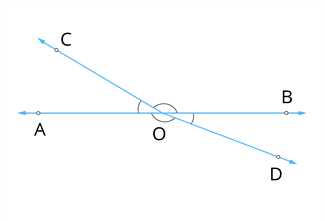
PUMPA - SMART LEARNING
எங்கள் ஆசிரியர்களுடன் 1-ஆன்-1 ஆலோசனை நேரத்தைப் பெறுங்கள். டாப்பர் ஆவதற்கு நாங்கள் பயிற்சி அளிப்போம்
Book Free DemoLinear pair:
Linear pair of angles should add up to 180°.
If the given two adjacent angles does not make the 180°, then it is not a linear pair.

We studied that the sum of all the angles formed at a point on a straight line is 180°.
Think what would be the angle if many rays arises from a single point!
All the rays are starting from a single point. So the sum of the angles around a point will be 360°.
Now we understand this with some example.
Observe the below figure. Here AB is a straight line. And OC is a ray meeting AB at O. It is evident that and is a linear pairs, so it makes the angles of 180°.

Also the another ray OD meeting AB at O. Then and is a linear, which makes 180°.
We can observe that all the angles , , and are originated at the point of O.
Therefore, .
Hence, it is clear that the sum of the angles at a point will be 360°.